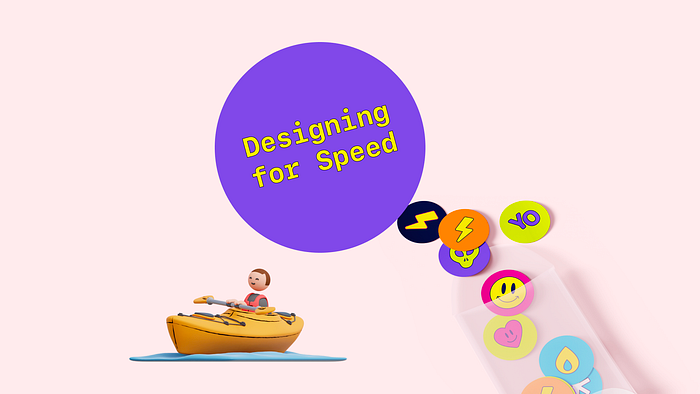By making the site 1 second faster we could increase engagement by 5%

Designing for speed in UX/UI is crucial for creating a positive user experience and maximizing engagement.
Here’s why it’s so important:
1. User Expectations: Users have become accustomed to fast-loading websites and apps. Slow experiences can lead to frustration, abandonment, and negative perceptions of your brand.
2. First Impressions: Website speed is often the first impression users have of your platform. A fast-loading site establishes a positive tone and encourages users to explore further.
3. Reduced Bounce Rates: Faster loading times decrease bounce rates, as users are more likely to stay and engage with content when pages load quickly.
4. User Retention: Speedy experiences lead to longer user sessions, as users are more inclined to navigate through more pages and interact with more content.
5. Mobile Optimization: With mobile browsing on the rise, fast loading times are even more critical. Slow sites on mobile devices can deter users and negatively impact engagement.
6. SEO Benefits: Search engines factor in page speed when ranking websites. Fast-loading sites have a higher chance of ranking higher in search results, driving organic traffic and engagement.
7. Conversion Rates: A seamless, fast experience contributes to higher conversion rates. E-commerce sites, for instance, benefit from improved load times leading to more completed purchases.
8. Usability: Slow-loading sites can impede users’ ability to interact with elements, leading to frustrated interactions and potential usability issues.
9. User Satisfaction: Speed is a fundamental aspect of usability. A fast website communicates that you value your users’ time and experience, enhancing overall satisfaction.
10. Global Reach: Fast-loading sites accommodate users across various regions and internet speeds, allowing you to cater to a broader audience.
11. Competitive Edge: In a saturated digital landscape, speed can set you apart from competitors. Users are more likely to choose the faster, more user-friendly option.
12. Brand Perception: A well-designed, fast site fosters a positive brand image, reflecting professionalism and reliability.
13. Accessibility: Fast-loading sites are more accessible to users with disabilities or limited connectivity, ensuring a better experience for everyone.
14. Resource Efficiency: Optimized designs that prioritize speed tend to use fewer resources, resulting in lower server costs and reduced environmental impact.
15. Future-Proofing: As technology evolves, designing for speed ensures your platform remains adaptable and relevant in an increasingly fast-paced digital world.
Incorporating speed into your UX/UI design strategy benefits both users and your business by enhancing engagement, satisfaction, and conversion rates. By prioritizing speed, you create a strong foundation for a successful and user-centric digital experience.
Some statistics for the understanding of speed in design
The impact of improving a website’s loading speed by just one second can have significant implications for user engagement and overall business success. Here’s a deeper look into why this seemingly small change can yield a substantial increase in engagement:
- Akamai Study (2009):
Akamai’s research showed that a 1-second delay in page load time led to a 7% decrease in conversions. - Kissmetrics Study (2011):
Kissmetrics found that 47% of consumers expect a web page to load in 2 seconds or less. Additionally, 40% of users abandon a website that takes more than 3 seconds to load. - Walmart Case Study (2012):
Walmart experienced a 2% increase in conversions for every 1-second improvement in page load time. This highlights the direct correlation between faster loading times and improved business metrics. - Amazon Revenue Impact (2012):
Amazon reported that for every 100 milliseconds of improvement in load time, their revenue increased by 1%. - Google Research (2016):
Google reported that 53% of mobile site visits were abandoned if a page took longer than 3 seconds to load. - Neil Patel Analysis (2016):
Neil Patel’s research indicated that a 1-second delay in load time could result in a 16% decrease in customer satisfaction and an 11% drop in page views. - Pinterest Case Study (2017):
Pinterest increased its search engine traffic and sign-ups by 15% simply by reducing perceived wait times by 40%. - MachMetrics Data (2017):
MachMetrics, a website speed monitoring service, found that a 2-second delay in load time led to an abandonment rate of over 10%. - Akamai Study (2017):
Akamai reported that a 100-millisecond delay in website load time could lead to a 7% decrease in conversion rates. Faster loading times contribute to improved user experiences and higher conversion rates. - Google Study (2018):
Google found that as page load time increases from 1 second to 5 seconds, the probability of bounce increases by 90%. This means that even a 1-second delay in loading time can substantially impact user engagement and retention. - Pingdom Research (2018):
According to Pingdom’s analysis of 750,000 websites, the average load time for a webpage is around 3.21 seconds. Websites that loaded in under 2 seconds had a bounce rate of 9%, while sites loading in 5 seconds had a bounce rate of 38%. - WebPageTest.org Research (2018):
According to WebPageTest.org, a website speed improvement from 5 seconds to 3 seconds led to a 25% decrease in bounce rate. - Unbounce Study (2019):
Unbounce’s analysis indicated that a 1-second delay in mobile load times could impact conversion rates by up to 20%. - Mobile Users (2019):
A Google study revealed that the average time it takes to load a mobile landing page fully is 15 seconds. However, the probability of bounce increases to 32% as the load time goes from 1 to 3 seconds. For each additional second of load time, the bounce rate increases by 90%. - Fastly Survey (2019):
Fastly’s survey found that 70% of respondents indicated that page load time affects their willingness to buy from an online retailer.
For the latest and most accurate statistics on the impact of website speed on user engagement, I recommend checking reputable sources such as research studies, industry reports, and web performance organizations. These sources can provide you with the most current and relevant data regarding the relationship between website speed and user engagement.

